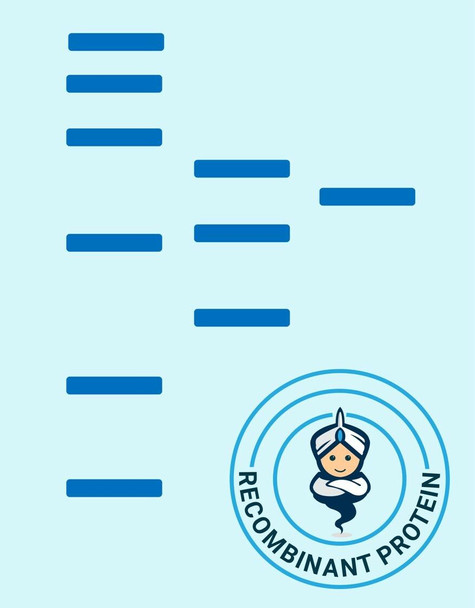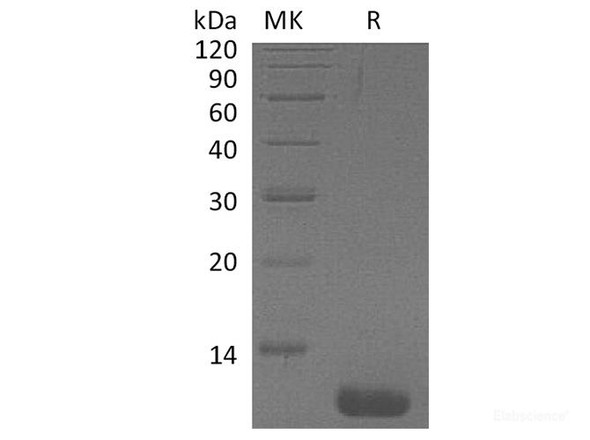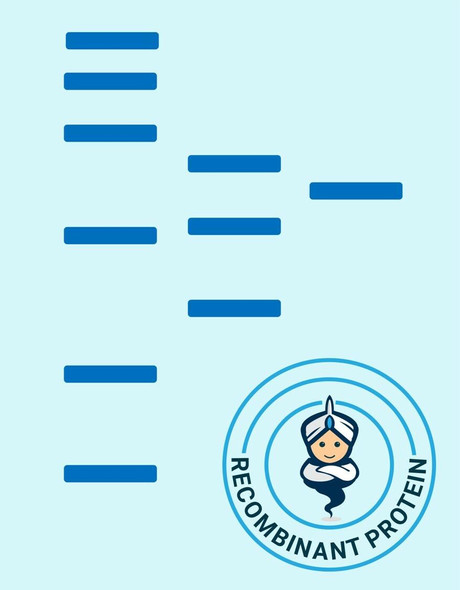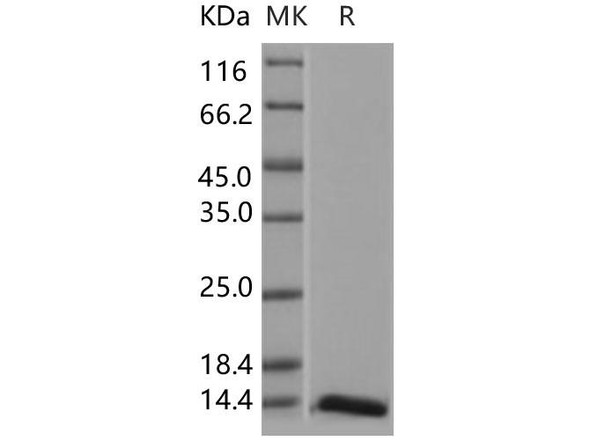Description
| Product Name: | Human I TAC Recombinant Protein |
| Product Code: | RPPB1175 |
| Size: | 20µg |
| Species: | Human |
| Target: | I TAC |
| Synonyms: | Small inducible cytokine B11, CXCL11, I-TAC, IP-9, H174, Beta-R1, chemokine (C-X-C motif) ligand 11, IP9, b-R1, SCYB11, SCYB9B, MGC102770. |
| Source: | Escherichia Coli |
| Physical Appearance: | Sterile Filtered White lyophilized (freeze-dried) powder. |
| Formulation: | Lyophilized from a 0.2?m filtered concentrated (0.5mg/ml) solution in 20mM PB, pH 7.4, 100mM NaCl. |
| Solubility: | It is recommended to reconstitute the lyophilized I-TAC in sterile 18M?-cm H2O not less than 100�g/ml, which can then be further diluted to other aqueous solutions. |
| Stability: | Lyophilized I-TAC although stable at room temperature for 3 weeks, should be stored desiccated below -18°C. Upon reconstitution�I-TAC should be stored at 4°C between 2-7 days and for future use below -18°C. For long term storage it is recommended to add a carrier protein (0.1% HSA or BSA).Please prevent freeze-thaw cycles. |
| Purity: | Greater than 97.0% as determined by:(a) Analysis by RP-HPLC.(b) Analysis by SDS-PAGE. |
| Amino Acid Sequence: | FPMFKRGRCLCIGPGVKAVKVADIEKASIMYPSNNCDKIEVIITLKENKGQRCLNPKSKQARLIIKKVERKNF |
| Biological Activity: | Determined by its ability to chemoattract human IL-2 activated T-Lymphocytes using a concentration range of 0.1-10.0 ng/ml. |
Chemokine (C-X-C motif) ligand 11 (CXCL11) is a small cytokine belonging to the CXC chemokinen family that is also called inducible T-cell alpha chemoattractant (I-TAC) and (IP-9). I-TAC is highly expressed in peripheral blood leukocytes, pancreas and liver, with moderate levels in thymus, spleen and lung and low expression levels were in small intestine, placenta and prostate. Gene expression of CXCL11 is strongly induced by IFN-g and IFN-b, and weakly induced by IFN-a. The I-TAC�chemokine elicits its effects on its target cells by interacting with the cell surface chemokine receptor CXCR3, with a higher affinity than do the other ligands for this receptor, CXCL9 and CXCL10. I-TAC is chemotactic for activated T cells.�The CXCL11 gene is located on human chromosome 4 along with many other members of the CXC chemokine family.
I-TAC Human Recombinant produced in E.Coli is a single, non-glycosylated, polypeptide chain containing 73 amino acids and having a molecular mass of 8300 Dalton. The I-TAC is purified by proprietary chromatographic techniques.
| UniProt Protein Function: | CXCL11: Chemotactic for interleukin-activated T-cells but not unstimulated T-cells, neutrophils or monocytes. Induces calcium release in activated T-cells. Binds to CXCR3. May play an important role in CNS diseases which involve T-cell recruitment. May play a role in skin immune responses. Belongs to the intercrine alpha (chemokine CxC) family. |
| UniProt Protein Details: | Protein type:Motility/polarity/chemotaxis; Chemokine; Secreted; Secreted, signal peptide Chromosomal Location of Human Ortholog: 4q21.2 Cellular Component: extracellular space; extracellular region Molecular Function:heparin binding; protein binding; CXCR3 chemokine receptor binding; chemokine activity Biological Process: G-protein coupled receptor protein signaling pathway; cell-cell signaling; immune response; positive regulation of leukocyte chemotaxis; response to lipopolysaccharide; positive regulation of release of sequestered calcium ion into cytosol; positive regulation of cAMP metabolic process; signal transduction; chemotaxis; inflammatory response; regulation of cell proliferation |
| NCBI Summary: | Chemokines are a group of small (approximately 8 to 14 kD), mostly basic, structurally related molecules that regulate cell trafficking of various types of leukocytes through interactions with a subset of 7-transmembrane, G protein-coupled receptors. Chemokines also play fundamental roles in the development, homeostasis, and function of the immune system, and they have effects on cells of the central nervous system as well as on endothelial cells involved in angiogenesis or angiostasis. Chemokines are divided into 2 major subfamilies, CXC and CC. This antimicrobial gene is a CXC member of the chemokine superfamily. Its encoded protein induces a chemotactic response in activated T-cells and is the dominant ligand for CXC receptor-3. The gene encoding this protein contains 4 exons and at least three polyadenylation signals which might reflect cell-specific regulation of expression. IFN-gamma is a potent inducer of transcription of this gene. Two transcript variants encoding different isoforms have been found for this gene. [provided by RefSeq, Oct 2014] |
| UniProt Code: | O14625 |
| NCBI GenInfo Identifier: | 7674360 |
| NCBI Gene ID: | 6373 |
| NCBI Accession: | O14625.1 |
| UniProt Related Accession: | O14625 |
| Molecular Weight: | |
| NCBI Full Name: | C-X-C motif chemokine 11 |
| NCBI Synonym Full Names: | C-X-C motif chemokine ligand 11 |
| NCBI Official Symbol: | CXCL11�� |
| NCBI Official Synonym Symbols: | IP9; H174; IP-9; b-R1; I-TAC; SCYB11; SCYB9B�� |
| NCBI Protein Information: | C-X-C motif chemokine 11 |
| UniProt Protein Name: | C-X-C motif chemokine 11 |
| UniProt Synonym Protein Names: | Beta-R1; H174; Interferon gamma-inducible protein 9; IP-9; Interferon-inducible T-cell alpha chemoattractant; I-TAC; Small-inducible cytokine B11 |
| UniProt Gene Name: | CXCL11�� |
| UniProt Entry Name: | CXL11_HUMAN |









